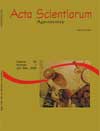Penalization model of maize productivity by CERES-Maize
Abstract
The present work analyzes penalization imposed by the CERES-Maize model in the corn yield variables. The direct soil water evaporation and the crop evapotranspiration were also studied according to CERES-Maize model and SISDA 3.0, using crop coefficient to calculate evapotranspiration and penalization of soil water under field capacity. To compare simulated data with experimental results, a cornfield experiment was carried out with the following treatments: five irrigation water depths and two coefficients of uniformity of water application. Based on simulations and on experimental conditions, it was concluded that the penalization imposed by the model influenced severely the corn crop yield, for treatments with soil water deficit. The soil water evaporation and the crop transpiration calculated by the CERES-Maize model overestimated the rate of the reference evapotranspiration calculated by Penman-Monteith equation. The corn crop evapotranspiration calculated by CERES-Maize model overestimated the real crop water needs.Downloads
Download data is not yet available.
Published
2008-04-11
How to Cite
Freitas, P. S. L. de, Mantovani, E. C., Sediyama, G. C., & Costa, L. C. (2008). Penalization model of maize productivity by CERES-Maize. Acta Scientiarum. Agronomy, 27(1), 97-105. https://doi.org/10.4025/actasciagron.v27i1.2125
Issue
Section
Agricultural Engineering
DECLARATION OF ORIGINALITY AND COPYRIGHTS
I Declare that current article is original and has not been submitted for publication, in part or in whole, to any other national or international journal.
The copyrights belong exclusively to the authors. Published content is licensed under Creative Commons Attribution 4.0 (CC BY 4.0) guidelines, which allows sharing (copy and distribution of the material in any medium or format) and adaptation (remix, transform, and build upon the material) for any purpose, even commercially, under the terms of attribution.
2.0
2019CiteScore
60th percentile
Powered by 

2.0
2019CiteScore
60th percentile
Powered by 



















































